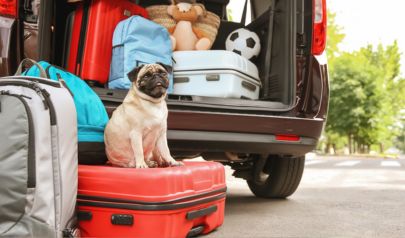A Guide to Road Trips with Pets

Road trips can be enjoyable, but they can also be stressful. When driving long distances with your pets, planning can make all the difference between a great experience and a doomsday event. Our Guide to Road Trips with Pets will help you set up your summer road trips for success!
Planning/Preparing
At least one month before your trip, take your pet to the vet for any necessary check-ups, shots, or health issues. Communicate with your veterinarian about your trip, destination, duration, and travel plans (hotels, campgrounds, etc.). Some geographical areas present different challenges for pets, like ant infestations and ticks. Your vet can help you with these concerns.
If your pet is prone to travel sickness, you may want a prescription to fight nausea. If they are anxious travelers, some vets will prescribe travel medications.
Make sure your pet has updated vaccinations, tags, a working microchip, etc. You will also want to take the right kinds of food, treats, and fluids. Measuring out your food will prevent inconvenient side trips to find pet food. Your animal will do best if they continue to eat the food they are most familiar with. Introducing new food on a road trip can be hard on everyone. Be sure to bring extra food and water in preparation for any travel delays.
TIP: Some premium pet stores will give you sample packs of food for traveling (especially for smaller pets). This can save both money and time when packing.
Safety Concerns
Every pet needs to be secure in the car when traveling. Roaming pets in the car can be family fun – but are also a driving danger. Safety is key.
Most pets will do best in a regulation carrier designed for their body size and shape. They tend to snuggle in and stay quiet in their secure space. However, some social pets want to be…well…social. There are travel leashes designed to help keep your pet safe while preventing driver distractions.
Another safety concern centers on regular breaks. Some pets won’t eat or drink when traveling in a vehicle, so stops allow them to stretch their legs, drink some water, and sometimes have a snack.
Possibly the MOST IMPORTANT SAFETY GUIDELINE IS THIS: NEVER LEAVE YOUR PET ALONE IN THE VEHICLE. It’s tempting to pull up to a stop, have everyone unload (except your pet), and come back after a meal or bathroom break. Remember that cars tend to heat up and cool down quickly and can put your pet’s life at risk.
Traveling with pets is a little like traveling with small children. They need to be secure, never left alone, and cared for along the way.
Comfort and Climate
Every human knows how to communicate their discomfort. We say, “Turn up the AC,” or, “Can I get my pillow out?” Pets can’t communicate directly with a language we understand. They often communicate through whining, clawing, breathing heavily, or barking.
Before you take off, let your pet become acquainted with the vehicle and passengers. They often just need to know who’s where and what their environment looks like to settle in for the trip. Consider where your pet is located in the vehicle. Sometimes carriers can end up right next to a floor vent shooting out heat or AC. This can make them too hot or too cold. Choose wisely so they are well ventilated, but not uncomfortable because of extreme temperatures.
TIP: Make sure you take their favorite blanket and “snuggle” toy. This helps them – either in a carrier or out – to feel secure.
Communication with Companions
Anytime you are taking a road trip with your pet, it’s important that everyone on the trip understands the attention and care needed for your animal companions. Having a pre-trip meeting can set expectations for stops, duties, eating, drinking, safety harnesses, etc. As they say, “Expectation is everything.” Setting expectations up front makes for the best possible outcome.
Road Trip Checklist
- Veterinarian Appointment (one month before departure)
- Microchip Confirmed
- Updated Vaccinations
- Trip Medications (if any, and only those recommended by your veterinarian)
- Safety Carrier/Harness
- Leash, Collar, Tags
- Food Supplies
- Watering Solutions
- Travel Blanket and Toys
- Pre-Trip Meeting
- Animal Vehicle Exploration
- Locate Carrier/Harness for Optimal Safety
- Plan Stops (every 2-3 hours)
- Have A Great Trip!!